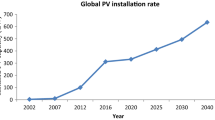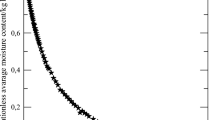Abstract
The extractive distillation of an isobutanol–isobutyl acetate mixture using dimethylformamide has been considered. Schemes that use vapor recompression heat pumps and partially thermally coupled distillation systems both without and with a heat pump are considered in comparison with the conventional schemes. It is shown that the use of heat pumps in the process under investigation allows for a considerable reduction in the energy consumption and total annual costs.



Similar content being viewed by others
REFERENCES
King, C.J., Separation processes, New York: Dover, 2013, 2nd ed.
Kiss, A.A. and Olujić, T., A review on process intensification in internally heat-integrated distillation columns, Chem. Eng. Process., 2014, vol. 86, p. 125.
Timoshenko, A.V., Anokhina, E.A., Rudakov, D.G., Timofeev, V.S., Tatsievskaya, G.I., and Matyushenkova, Yu.V., Energy saving in distillation using complexes with coupled flows, Vestn. MITKHT, 2011, vol. 6, no. 4, pp. 28–40.
Null, H.R., Heat pumps in distillation, Chem. Eng. Prog., 1976, vol. 72, no. 7, p. 58.
Jana, A.K., Heat integrated distillation operation, Appl. Energy, 2010, vol. 87, no. 5, p. 1477.
Gaile, A.A. and Somov, V.E., Protsessy razdeleniya i ochistki produktov pererabotki nefti i gaza (Processes for Separation and Purification of Oil and Gas Processing Products), St. Petersburg: Khimizdat, 2012.
Pavlov, S.Yu., Vydelenie i ochistka monomerov dlya sinteticheskogo kauchuka (Recovery and Purification of Monomers for Synthetic Rubber), Leningrad: Khimiya, 1987.
Meirelles, A., Weiss, S., and Herfurth, H., Ethanol dehydration by extractive distillation, J. Chem. Technol. Biotechnol., 1992, vol. 53, p. 181.
Arifin, S. and Chien, I.-L., Design and control of an isopropyl alcohol dehydration process via extractive distillation using dimethyl sulfoxide as an entrainer, Ind. Eng. Chem. Res., 2008, vol. 47, no. 3, p. 790.
Luyben, W.L., Comparison of pressure-swing distillation and extractive distillation methods for methanol-recovery systems in the TAME reactive-distillation process, Ind. Eng. Chem. Res., 2005, vol. 44, no. 15, p. 5715.
Luyben, W.L., Comparison of extractive distillation and pressure-swing distillation for acetone-methanol separation, Ind. Eng. Chem. Res., 2008, vol. 47, no. 8, p. 2696.
Wang, S.-J., Huang, H.-P., and Yu, C.-C., Plantwide design of transesterification reactive distillation to co-generate ethyl acetate and n-butanol, Ind. Eng. Chem. Res., 2010, vol. 49, no. 2, p. 750.
Anokhina, E.A., Energy saving in extractive distillation processes, Vestn. MITKHT, 2013, vol. 8, no. 5, p. 3.
You, X., Rodriguez-Donis, I., and Gerbaud, V., Reducing process cost and CO2 emissions for extractive distillation by double-effect heat integration and mechanical heat pump, Appl. Energy, 2016, vol. 166, p. 128.
Anokhina, E.A., Rudakov, D.G., and Timoshenko, A.V., Extractive distillation of the isobutyl alcohol–isobutyl acetate mixture with dimethylformamide, Khim. Tekhnol., 2011, vol. 12, no. 10, p. 627.
Timoshenko, A.V. and Anokhina, E.A., Modeling and optimization as a tool for developing high-efficiency distillation flow diagrams, Ross. Tekhnol. Zh., 2017, vol. 5, no. 3, p. 138.
Anokhina, E.A., Dolmatov, B.B., and Timoshenko, A.V., Energy efficiency of extractive distillation of the acetone– chloroform mixture in a complex column with a side section, Khim. Tekhnol., 2008, vol. 9, no. 8, p. 402.
Plesu, V., Bonet-Ruiz, A.E., Bonet, J., and Llorens, J., Simple equation for suitability of heat pump use in distillation, Proc. 24th European Symposium on Computer Aided Process Engineering, Klemeš, J.J., Varbanov, S.V., and Liew, P.Y., Eds., Amsterdam: Elsevier, 2014, p. 1327.
Funding
This study was supported by the Russian Foundation for Basic Research, project no. 20-03-00314.
Author information
Authors and Affiliations
Corresponding author
Additional information
Translated by O. Lotova
Rights and permissions
About this article
Cite this article
Klauzner, P.S., Rudakov, D.G., Anokhina, E.A. et al. Use of Partially Thermally Coupled Distillation Systems and Heat Pumps for Reducing the Energy Consumption in the Extractive Distillation of an Isobutanol–Isobutyl Acetate Mixture Using Dimethylformamide. Theor Found Chem Eng 54, 397–406 (2020). https://doi.org/10.1134/S0040579520030070
Received:
Revised:
Accepted:
Published:
Issue Date:
DOI: https://doi.org/10.1134/S0040579520030070




